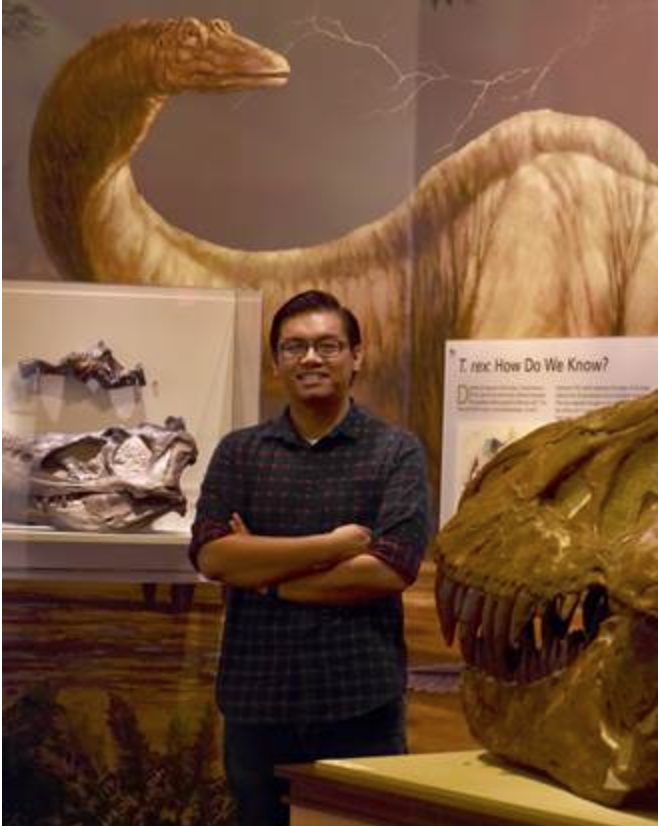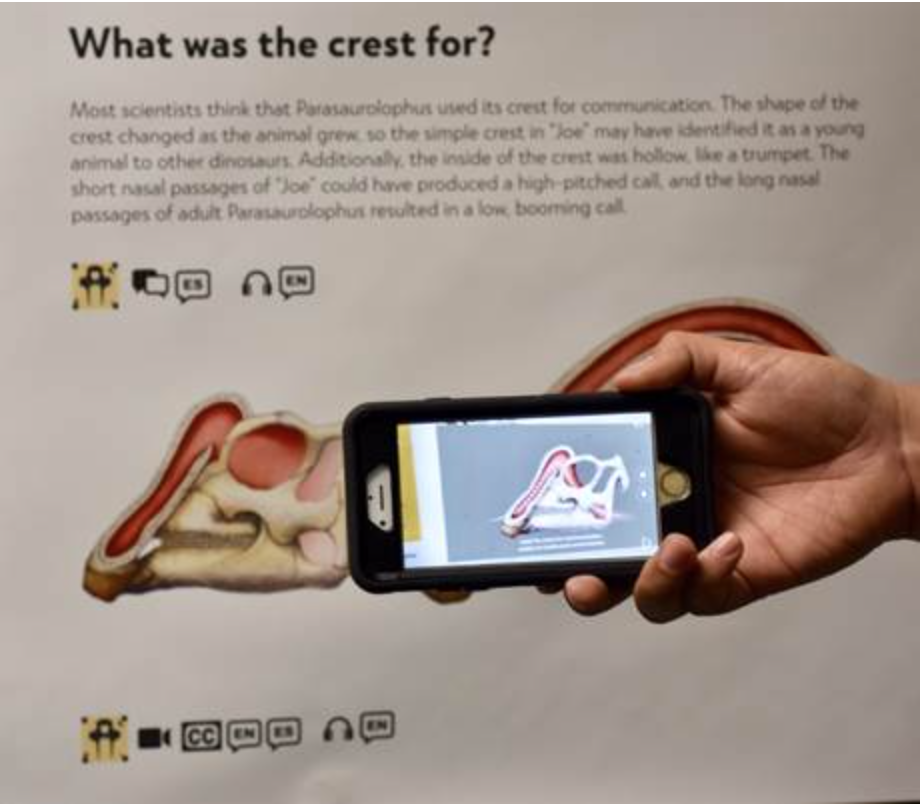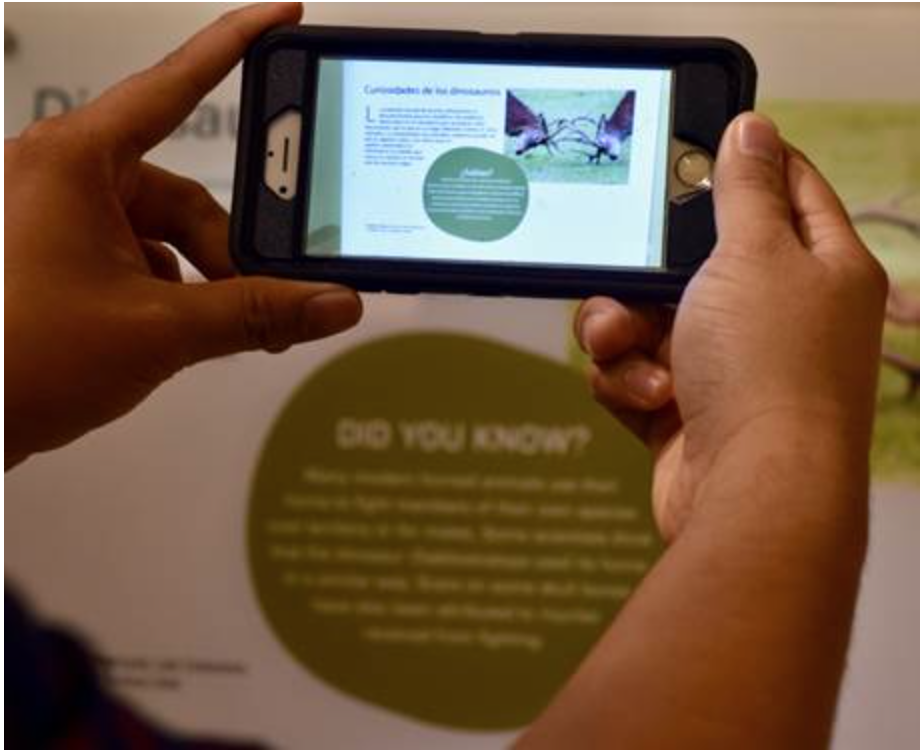Have you ever been to a museum and struggled to understand the signs because the text was tiny or not in your native language? Been given a pamphlet with obscure shapes mapping the display in front of you, leaving you to your own devices to decipher the map and decode the accompanying description? This type of experience creates a disconnect between the visitor and the display. It reinforces an English-speaking-only able-ist environment that leads anyone outside that demographic to be less engaged in the topic. Gabe Santos, of the Raymond G. Alf Museum of Paleontology, is breaking down those barriers using augmented reality.

Santos is passionate about making museum exhibits accessible. The son of Filipino immigrants, he entered UC Irvine as an undergraduate intending to go to medical school. But he loved storytelling too, which explains why he shifted to paleontology – a field that studies millions of years of recorded stories. It wasn’t an easy transition: his family expected him to go into medicine and they did not all understand why someone would study fossils. From the beginning of his paleontological career, Santos had to translate his work and its importance.
When he started as the Collections Manager at the Alf Museum in Claremont, California, he found that the challenges of translation in his personal life were mirrored in the museum visitors. In a Southern California community with many immigrants and non-native speakers, Santos watched as students were forced to translate exhibits from English for their parents. Language was a constant barrier for the surrounding community to fully engage with the museum exhibits.
Traditionally, museums address a language barrier by providing extra pamphlets that visitors carry around so that they can try to match what they’re viewing with information in a booklet. This creates a disconnect and forces people to read from a book rather than looking at the exhibit itself. Children have to translate for their parents, making visits less enjoyable and more burdensome for kids. Santos and his colleague, Tara Lepore, decided that since science should be for everybody, they needed to find ways to actually make it accessible for everyone. It’s not just about finding an audience already interested in science, says Santos, but inspiring non-scientists to engage in science and enjoy it. It’s impossible to engage the community when the material is not in their native language.
But translating huge displays and making new signage is expensive, and museums (especially small education-based ones like Alf) have limited budgets. For a self-described techy like Santos, turning to technology was an inexpensive and engaging way to make the material more accessible. He turned to augmented reality (AR) technology from the gaming industry to create supplemental material in digital overlays for the Alf’s exhibits. A visitor can simply point their phone’s camera at an exhibit, and an AR overlay pops up. The overlay could be a video of a scientist describing the excavation process for the fossil, or an animation that brings the exhibit to life.

Santos and Lepore then asked, what if we used this AR as an accessibility tool instead of just to create supplementary material? AR can be integral to the general experience of museum visiting, and would make the exhibits much more accessible to non-native English speakers.
They began working with other educators and artists to create digital overlays that translate material into multiple languages. Recognizing a lack of intersectionality with culture and language in traditional museum teaching, Santos worked with colleagues who are native Spanish and Chinese speakers to ensure that translated material was contextually relevant.
Santos and his colleagues tested their new app with visitors at the Alf Museum. Participants found that the AR was easy to use and provided a good experience – parents didn’t need to rely on their kids to translate for them. For museum staff, creating free and quick content that significantly improves the experience for their visitors is a huge achievement. The Alf Museum is now working on providing devices to lend to visitors, to break down the economic barrier of owning smart phones or tablets.

Santos recognized another major barrier to inclusive museum learning: the diversity of disabilities and learning differences. What if AR could be used not just to translate material into other languages, but to create inclusive accessibility for visitors with disabilities? Santos is working on creating videos with audio dictation in multiple languages which, combined with Alf’s open-air and tactile exhibits, create a more inclusive experience for visitors with visual impairments. He is also working with other educators who have experience in creating content for visitors with learning disabilities or who are on the autistic spectrum. Creating diverse types of overlays enables visitors to engage in a meaningful and comfortable way with the exhibits.
Santos uses an app called HP Reveal. It’s free and simple to use. Santos showed me how quick it is to make the AR content. All you have to do is specify a trigger image (maybe a fossil or sign), specify a digital overlay (e.g., translated text, video, or animation), and publish it! Modifying content can be done instantaneously, so it’s easy to update material.
Other museums are starting to express interest in using this content, but only a few people have turned that interest into action. Dr. Bolortsetseg Minjin, a dinosaur paleontologist with the American Museum of Natural History (AMNH), created the Institute for Study of Mongolian Dinosaurs (ISMD). AMNH donated a mobile museum to ISMD so they could travel throughout Mongolia, where many amazing dinosaur fossils have been discovered, and bring paleontological science to children in very underserved communities where science education is scarce, including knowledge of the dinosaurs found in their own backyards. The problem with this mobile museum? The displays are all in English. But when Dr. Minjin, from Mongolia herself, visited the Alf Museum to receive an award, she met Gabe and began working with him to create AR content to translate the material into Mongolian. Santos hopes that the ease of use of this technique will break down the activation barrier for other museums, universities, and exhibit halls.
Santos suggests other applications of AR that can make science more inclusive and accessible: university research displays; informational displays at field sites; and posters at conferences (the large number of people who visited Santos’ poster at the 2018 SICB Annual Meeting is just one measure of support for this idea). The possibilities are endless.
Santos and his colleagues are pioneering means of making science more accessible and inclusive to a diverse public audience. By using AR, they are engaging the public in new ways while breaking down barriers from language or disabilities. Santos hopes that people creating education or science communication content include accessibility and inclusivity at the forefront of any planning. If this way of thinking becomes the standard, then we can make science truly available to everyone.
By Alyssa Frederick, University of California, Irvine

